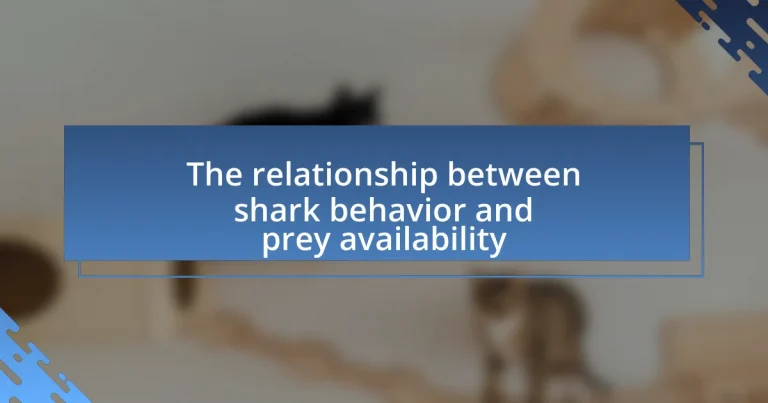The article examines the relationship between shark behavior and prey availability, highlighting how sharks adapt their hunting strategies and movement patterns based on the abundance of food sources. It discusses the impact of prey density on shark foraging behavior, including increased aggression and social interactions when prey is plentiful, and changes to opportunistic feeding tactics during scarcity. Additionally, the article emphasizes the ecological significance of this relationship, detailing how sharks, as apex predators, help maintain marine ecosystem balance and the implications of human activities such as overfishing and habitat destruction on prey populations. Understanding these dynamics is crucial for effective conservation strategies aimed at sustaining both shark and prey species.

What is the relationship between shark behavior and prey availability?
Shark behavior is directly influenced by prey availability, as sharks exhibit hunting patterns and movement based on the presence and abundance of their food sources. For instance, studies have shown that sharks tend to migrate to areas with higher prey density, such as schools of fish or marine mammals, which enhances their foraging success. Research conducted by Heithaus et al. (2008) in “Sharks and Their Prey: The Role of Prey Availability in Shark Behavior” indicates that when prey is scarce, sharks may alter their hunting strategies, becoming more opportunistic or expanding their search areas to locate food. This relationship underscores the adaptive nature of sharks in response to ecological conditions, demonstrating that prey availability is a critical factor in shaping their behavior.
How do sharks adapt their behavior based on prey availability?
Sharks adapt their behavior based on prey availability by altering their hunting strategies, movement patterns, and social interactions. For instance, when prey is abundant, sharks may exhibit increased foraging activity and aggressive hunting behaviors, such as coordinated group hunting or increased speed to capture fast-moving prey. Conversely, during periods of low prey availability, sharks may reduce their activity levels, migrate to different areas in search of food, or switch to alternative prey types. Research has shown that species like the great white shark can modify their hunting techniques based on the type and density of available prey, demonstrating their ability to optimize energy expenditure while maximizing feeding opportunities.
What specific behaviors do sharks exhibit when prey is abundant?
When prey is abundant, sharks exhibit increased feeding activity and aggressive hunting behaviors. This includes heightened social interactions among sharks, as they may gather in larger numbers to exploit the plentiful food source. Additionally, sharks may display more frequent and varied hunting techniques, such as ambushing or herding prey into tight groups, which enhances their feeding efficiency. Research indicates that species like the great white shark will engage in more surface breaching and increased movement patterns when prey, such as seals, are readily available, demonstrating their adaptability to prey density.
How do sharks change their hunting strategies when prey is scarce?
Sharks adapt their hunting strategies when prey is scarce by altering their foraging patterns and increasing their range of movement. Research indicates that in low-prey environments, sharks may switch from active hunting to opportunistic feeding, targeting less mobile or more abundant prey types. For example, studies have shown that species like the great white shark will expand their search area and may also increase their reliance on ambush tactics, utilizing camouflage and stealth to capture prey that is less vigilant. This behavioral flexibility allows sharks to optimize their energy expenditure while maximizing their chances of successful predation in challenging conditions.
Why is understanding this relationship important for marine ecosystems?
Understanding the relationship between shark behavior and prey availability is crucial for marine ecosystems because it directly influences the balance of marine food webs. Sharks play a key role as apex predators, regulating prey populations and maintaining the health of marine habitats. For instance, studies have shown that when shark populations decline, there can be an overabundance of prey species, leading to overgrazing of seagrass and coral reefs, which are vital for biodiversity. This dynamic illustrates how the presence and behavior of sharks can affect not only their immediate prey but also the broader ecological community, highlighting the importance of conserving shark populations to sustain marine ecosystem health.
What role do sharks play in maintaining the balance of marine life?
Sharks play a crucial role in maintaining the balance of marine life by acting as apex predators that regulate the populations of various species within the ecosystem. Their predation helps control the abundance of prey species, which in turn influences the overall health and diversity of marine habitats. For instance, studies have shown that the removal of sharks can lead to an overpopulation of smaller fish and invertebrates, resulting in the depletion of seagrass and coral reef ecosystems due to overgrazing. This dynamic illustrates how sharks contribute to the stability and resilience of marine environments by ensuring that no single species dominates the ecosystem, thereby promoting biodiversity and ecological balance.
How does prey availability impact shark populations and health?
Prey availability significantly impacts shark populations and health by influencing their growth, reproduction, and overall well-being. When prey is abundant, sharks can thrive, leading to increased reproductive success and healthier individuals. Conversely, limited prey availability can result in malnutrition, decreased reproductive rates, and higher mortality rates among shark populations. For instance, studies have shown that regions with declining fish stocks often see a corresponding decline in shark populations, as evidenced by research conducted by the Marine Conservation Society, which highlights the direct correlation between prey abundance and shark health metrics.

What factors influence prey availability for sharks?
Prey availability for sharks is influenced by factors such as environmental conditions, prey population dynamics, and seasonal migrations. Environmental conditions, including water temperature, salinity, and habitat structure, affect the distribution and abundance of prey species. For instance, warmer waters often lead to increased productivity, attracting more prey. Additionally, the population dynamics of prey species, including their reproductive cycles and mortality rates, directly impact how many are available for sharks to feed on. Seasonal migrations of both sharks and their prey, driven by breeding or feeding patterns, also play a crucial role in determining prey availability. For example, certain fish species may migrate to spawn, temporarily reducing their availability in specific areas where sharks hunt.
How do environmental conditions affect prey populations?
Environmental conditions significantly influence prey populations by affecting their habitat, food availability, and reproductive success. For instance, temperature changes can alter the distribution of prey species, as many aquatic organisms are ectothermic and rely on specific temperature ranges for optimal growth and reproduction. Additionally, factors such as salinity, oxygen levels, and water quality directly impact prey health and abundance. Research indicates that shifts in ocean temperature can lead to changes in prey species composition, which in turn affects predator behavior, including that of sharks, as they adapt to the availability of different prey types.
What impact do water temperature and salinity have on prey species?
Water temperature and salinity significantly affect prey species by influencing their distribution, behavior, and reproductive cycles. For instance, many marine organisms, including fish and invertebrates, have specific temperature and salinity ranges that optimize their growth and survival. Research indicates that elevated water temperatures can lead to shifts in prey species’ habitats, often moving them to deeper or cooler waters, which can affect predator-prey dynamics. Additionally, salinity levels can impact osmoregulation in prey species, affecting their health and abundance. Studies have shown that changes in these environmental factors can lead to altered prey availability, which directly influences shark feeding behavior and overall ecosystem balance.
How do seasonal changes influence prey availability?
Seasonal changes significantly influence prey availability by altering environmental conditions such as temperature, light, and food resources. For instance, during warmer months, many aquatic ecosystems experience increased productivity, leading to higher populations of prey species like fish and invertebrates. This seasonal abundance is often linked to reproductive cycles, where many species spawn in spring and summer, resulting in a surge of juvenile prey. Conversely, in colder months, prey availability typically declines due to reduced metabolic rates and lower reproductive activity among species. Research indicates that these fluctuations in prey populations directly affect predator behavior, including that of sharks, which may migrate or alter feeding patterns in response to the availability of prey.
What human activities impact prey availability for sharks?
Human activities that impact prey availability for sharks include overfishing, habitat destruction, and pollution. Overfishing reduces the populations of smaller fish and marine organisms that serve as primary prey for sharks, leading to decreased food sources. For instance, studies have shown that the depletion of key fish species due to commercial fishing practices directly affects shark populations, as they rely on these species for sustenance. Habitat destruction, such as the degradation of coral reefs and mangroves, further diminishes the ecosystems that support prey species. Additionally, pollution introduces harmful substances into marine environments, which can lead to declines in prey populations and disrupt food webs. These activities collectively threaten the balance of marine ecosystems, ultimately impacting shark behavior and survival.
How does overfishing affect the prey species that sharks rely on?
Overfishing significantly reduces the populations of prey species that sharks rely on for food. As commercial fishing depletes these prey species, such as smaller fish and marine mammals, sharks face food scarcity, which can lead to decreased shark populations and altered behaviors. Research indicates that overfishing can lead to a 90% decline in certain fish populations, directly impacting the availability of food for apex predators like sharks. This disruption in the food chain can result in shifts in shark behavior, including changes in hunting patterns and migration routes, as they search for alternative food sources.
What role does habitat destruction play in altering prey availability?
Habitat destruction significantly reduces prey availability by disrupting ecosystems and diminishing the populations of species that sharks rely on for food. When habitats such as coral reefs, mangroves, and seagrass beds are destroyed, the complex environments that support diverse prey species are lost, leading to declines in their numbers. For instance, studies have shown that the degradation of coral reefs can lead to a 50% reduction in fish populations, which are crucial prey for many shark species. This decline in prey availability can force sharks to alter their foraging behavior, migrate to new areas, or face increased competition for the remaining food sources.

How can we study the relationship between shark behavior and prey availability?
To study the relationship between shark behavior and prey availability, researchers can utilize a combination of field observations, telemetry tracking, and ecological modeling. Field observations allow scientists to document shark feeding patterns and behaviors in relation to the presence of prey species. Telemetry tracking provides data on shark movements and habitat use, which can be correlated with prey distribution data collected through surveys or sampling. Ecological modeling can then be employed to analyze the interactions between shark populations and their prey, incorporating variables such as prey density and environmental factors. Studies have shown that areas with higher prey availability often correspond to increased shark activity, indicating a direct relationship between the two. For instance, research published in “Marine Ecology Progress Series” by Heithaus et al. (2008) demonstrated that tiger sharks exhibit increased foraging behavior in regions with abundant prey, reinforcing the importance of prey availability in influencing shark behavior.
What methods are used to observe shark behavior in relation to prey?
Researchers utilize various methods to observe shark behavior in relation to prey, including underwater video monitoring, acoustic telemetry, and direct observation through scuba diving. Underwater video monitoring allows for the continuous recording of shark interactions with prey in their natural habitat, providing visual data on hunting strategies and prey selection. Acoustic telemetry involves tagging sharks with transmitters that send location data to receivers, enabling scientists to track their movements and correlate them with prey availability in specific areas. Direct observation through scuba diving offers firsthand insights into shark behavior during feeding events, allowing researchers to document interactions in real-time. These methods collectively enhance understanding of the dynamics between shark behavior and prey availability, contributing to marine biology and conservation efforts.
How do researchers track shark movements and feeding patterns?
Researchers track shark movements and feeding patterns primarily through the use of satellite tagging and acoustic monitoring. Satellite tagging involves attaching a device to the shark that transmits location data to satellites, allowing researchers to monitor the shark’s movements over large distances. Acoustic monitoring uses underwater receivers to detect signals from tags implanted in sharks, providing detailed information on their movements and behaviors in specific areas. Studies have shown that these methods can reveal patterns related to prey availability, as sharks often migrate to areas with abundant food sources, demonstrating a direct relationship between their behavior and the distribution of prey.
What technologies are employed to study prey availability in marine environments?
Technologies employed to study prey availability in marine environments include acoustic telemetry, remote sensing, and underwater video systems. Acoustic telemetry allows researchers to track the movements of marine animals and their interactions with prey, providing data on spatial and temporal patterns of prey availability. Remote sensing utilizes satellite imagery and aerial surveys to assess oceanographic conditions and identify areas of high biological productivity, which correlate with prey abundance. Underwater video systems enable direct observation of prey species and their behaviors in natural habitats, offering insights into prey dynamics and availability. These technologies collectively enhance the understanding of prey availability, which is crucial for studying the relationship between shark behavior and their feeding ecology.
What are the implications of this research for conservation efforts?
The implications of this research for conservation efforts are significant, as understanding the relationship between shark behavior and prey availability can inform targeted conservation strategies. By identifying how changes in prey populations affect shark movements and feeding patterns, conservationists can better predict and mitigate the impacts of overfishing and habitat degradation on shark populations. For instance, if research shows that sharks migrate to specific areas based on prey availability, conservation efforts can focus on protecting those critical habitats to ensure the sustainability of both shark and prey species. This approach is supported by studies indicating that healthy prey populations are essential for maintaining shark biodiversity, which in turn supports marine ecosystem health.
How can understanding shark behavior inform marine protected area design?
Understanding shark behavior can significantly inform marine protected area (MPA) design by identifying critical habitats and movement patterns essential for their survival and reproduction. For instance, research indicates that sharks exhibit specific migratory routes and feeding behaviors that are closely linked to prey availability, such as schools of fish or other marine organisms. By mapping these behaviors, conservationists can establish MPAs in areas that not only protect sharks but also ensure the sustainability of their prey populations. Studies have shown that effective MPA design, which incorporates shark behavioral data, leads to improved biodiversity and ecosystem health, as sharks play a vital role as apex predators in marine ecosystems.
What strategies can be implemented to ensure sustainable prey populations?
To ensure sustainable prey populations, implementing regulated fishing practices is essential. These practices include setting catch limits based on scientific assessments, enforcing seasonal closures to allow populations to recover, and establishing marine protected areas where fishing is restricted. For instance, the implementation of catch limits in fisheries has been shown to lead to a 20% increase in fish populations over a decade, as evidenced by studies conducted by the Food and Agriculture Organization. Additionally, habitat restoration efforts, such as the protection of coastal ecosystems, can enhance prey availability by providing essential breeding and feeding grounds. Research indicates that restoring mangroves and seagrasses can increase local fish populations by up to 50%, thereby supporting the overall health of marine ecosystems.
What practical steps can be taken to support shark conservation?
To support shark conservation, individuals and organizations can implement several practical steps. Establishing marine protected areas (MPAs) is crucial, as these zones restrict fishing and habitat destruction, allowing shark populations to recover. Research indicates that MPAs can lead to a 50% increase in shark abundance within five years. Promoting sustainable fishing practices is also essential; for instance, using selective fishing gear reduces bycatch, which is a significant threat to shark species. Additionally, supporting legislation that bans shark finning can directly decrease the demand for shark fins, thereby protecting shark populations. Engaging in public education campaigns raises awareness about the ecological role of sharks, fostering community support for conservation efforts. Lastly, participating in citizen science initiatives helps gather data on shark populations, contributing to more effective conservation strategies.


